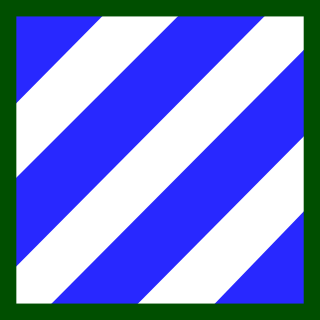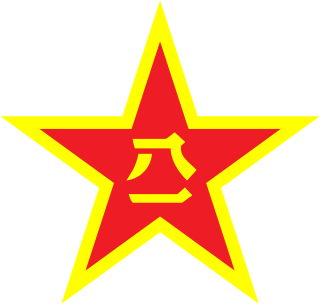Related Research Articles

The 3rd Infantry Division is a combined arms division of the United States Army based at Fort Stewart, Georgia. It is a direct subordinate unit of the XVIII Airborne Corps and U.S. Army Forces Command. Its current organization includes a division headquarters and headquarters battalion, two armored brigade combat teams, one National Guard infantry brigade combat team, one task force battalion, one aviation brigade, a division artillery, a sustainment brigade and a combat sustainment support battalion along with a maneuver enhancement brigade. The division has a distinguished history, having seen active service in World War I, World War II, the Korean War, Vietnam War, and the Global War on Terror. The Medal of Honor has been awarded to 61 members of the 3rd Infantry Division, making the division the most honored in the Army.

The Battle of the Imjin River, also known as the Battle of Solma-ri or Battle of Gloster Hill in South Korea, or as Battle of Xuemali in China, took place 22–25 April 1951 during the Korean War. Troops from the Chinese People's Volunteer Army (PVA) attacked United Nations Command (UN) positions on the lower Imjin River in an attempt to achieve a breakthrough and recapture the South Korean capital Seoul. The attack was part of the Chinese Spring Offensive, the aim of which was to regain the initiative on the battlefield after a series of successful UN counter-offensives in January–March 1951 had allowed UN forces to establish themselves beyond the 38th Parallel at the Kansas Line.
The 235th Mechanized Infantry Brigade, formerly the 79th Division, is a military formation of the People's Liberation Army Ground Force. It's now a maneuvering brigade of the PLA 71st Group Army.
The 80th Medium Combined Arms Brigade, formerly the 80th Division, is a military formation of the People's Liberation Army Ground Force. It's now a maneuver part of the PLA 82nd Group Army.
The 81st Division was a military formation of the People's Liberation Army during and after the Chinese civil war and a part of People's Volunteer Army during the Korean War. They were a component of the 27th Army.
The 20th Group Army is a military formation of the People's Liberation Army Ground Force, stationed in the Jinan Military Region. It consists of two manoeuvre brigades with other attached or otherwise organic units. For some time after its formation in 1949, the army consisted of three divisions.
The 113th Mechanized Infantry Division, now the 113th Medium Combined Arms Brigade, is a military formation of the People's Liberation Army of the People's Republic of China.
The 196th Light Combined Arms Brigade is a military formation of the People's Liberation Army of the People's Republic of China. It is one of the "showcase" units of the PLA ground force.
The 197th Army Division, then 5th Garrison Brigade of Beijing Military Region was a military formation of the People's Liberation Army of the People's Republic of China.
The 60th Corps was a military formation of the People's Liberation Army. During the Korean War it formed part of the CPV/PLA III Army Group.

The 58th Medium Combined Arms Brigade is a brigade of the People's Liberation Army Ground Force. It is one of the six combined arms brigades of the 83rd Group Army under the Central Theater Command. The 58th was previously a division, being converted to a brigade-sized formation in 1998.
The 199th Medium Combined Arms Brigade, formerly the 199th Motorized Infantry Brigade, is one of the six combined arms brigades of the 80th Group Army in the Northern Theater Command Ground Force.
The 1st Armored Brigade is an Armored formation of People's Liberation Army of the People's Republic of China. The brigade now serves as the armored element under the 65th Army in the Beijing Military Region.

The 72nd Group Army, formerly 1st Group Army, is a military formation of China's People's Liberation Army. It is one of three active group armies belonging to the Eastern Theater Command. The army is based at Huzhou, Zhejiang and is composed of the 1st Amphibious Mechanized Infantry Division, an armored division, an artillery division, a motorized infantry brigade, an engineer regiment and an air defense brigade. It is considered a Category A unit, with priority status in terms of readiness, strength, and modern equipment.
The 28th Group Army was an army corps of the Chinese People's Liberation Army that existed from 1949 to 1998. From 1952 to 1971, the 28th Army was based in Putian, Fujian and belonged to the Fujian Military Region. From 1971 to 1998, this army corps belonged to the Beijing Military Region and was based in Shanxi Province, initially in Houma and then in Datong. At the time of its dissolution in 1998, the 28th Army was composed of the 82nd, 83rd and 205th Infantry Divisions, the 7th Armored Division, an artillery brigade, an anti-aircraft brigade, an engineer regiment, a communication regiment and a reconnaissance battalion. The army corps’ unit ID number was 51366.
The 130th Army Division, now the 160th Heavy Combined Arms Brigade was a military formation of the People's Liberation Army Ground Force of the People's Republic of China. It is the only PLA division that took part in all three major wars of PLA after 1949.
The 11th Corps was a military formation of the Chinese People's Liberation Army. It was active from 1949 to 1952, with a six month break; and from 1969 to the end of 1985. It is currently inactive. In 1979 the corps took part in the Sino-Vietnamese War. In 1984 it again fought in Vietnam. It was stationed in the Kunming Military Region.
The 63rd Group Army, former 63rd Corps and 63rd Army Corps, was a military formation of China's People's Liberation Army existed from 1949 to 2003.
The 181st Division was created in February 1949 under the Regulation of the Redesignations of All Organizations and Units of the Army, issued by Central Military Commission on November 1, 1948, basing on the 37th Brigade, 13th Column of the Huabei Military Region Field Force. Its history could be traced to the Independent Anti-Japanese Detachment of the Eighth Route Army in Western Anhui, activated in September 1944.
The 179th Division was created in February 1949 under the Regulation of the Redesignations of All Organizations and Units of the Army, issued by Central Military Commission on November 1, 1948, basing on the 23rd Brigade, 8th Column of the Huabei Military Region Field Force. Its history could be traced to the 23rd Brigade of Taiyue Military District, activated in December 1945.